Steinmusic’s H2 Harmonizer, Magic Stones and E-Pads
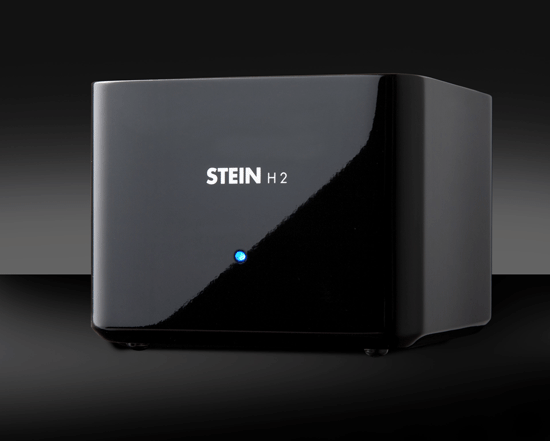
 Holger Stein, designer, inventor, and owner of Steinmusic, has numerous products to his credit. These include amplifiers, turntables, CD players, loudspeakers, cables, and some unusual accessories, such as cable and LP demagnetizers. Stein’s a one-man show. He’s the German equivalent of Japan’s Ken Ishiguro (Mr. Acoustic Revive). I recall seeing Stein’s Masterclass electronics at the Munich High End Show. And I met him at this year’s CES, where he was walking the show. He never mentioned any of his products to me, then or at any time thereafter. To my mind, that alone spells class and confidence, particularly in an industry where self-promotion is the norm.
Holger Stein, designer, inventor, and owner of Steinmusic, has numerous products to his credit. These include amplifiers, turntables, CD players, loudspeakers, cables, and some unusual accessories, such as cable and LP demagnetizers. Stein’s a one-man show. He’s the German equivalent of Japan’s Ken Ishiguro (Mr. Acoustic Revive). I recall seeing Stein’s Masterclass electronics at the Munich High End Show. And I met him at this year’s CES, where he was walking the show. He never mentioned any of his products to me, then or at any time thereafter. To my mind, that alone spells class and confidence, particularly in an industry where self-promotion is the norm.
Here in the States, Steinmusic has remained relatively unknown for the five years since its launch (Stein himself has been involved in the industry for much longer). And while brand appeal is a steep (and necessary) uphill battle for any startup company, his latest tweak – the Steinmusic H2 Harmonizer – may be the ticket Holger Stein is counting on to make him High End audio’s newest darling. This is its first public review.
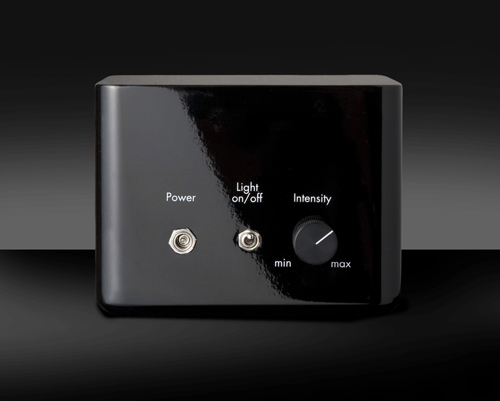
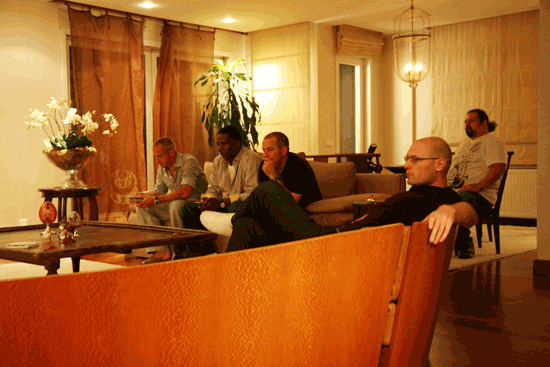
My interest in the H2 Harmonizer was piqued when Norbert Mundorf of MCap Capacitors fame (photo above on my left shoulder), was seen walking around providing demos at the recent Audio Expo of North America (APOXNA) held last month in Jacksonville, Florida. I didn’t need to hear it at this show for me to know there was something special about it. If Norbert Mundorf is walking around with a product he’s personally endorsing, then I’ll easily give it a try. After spending five days in Istanbul with Mundorf, mostly in intense discussions and demanding listening sessions, I discovered he’s the real deal when it comes to both music appreciation and listening experience. The listening sessions went into the wee hours of the morning and were unforgettable. If you see Mundorf or Frederik Caroe (of Duelund Denmark) walking the halls, offering demonstrations of their products… trust me, it’s worth a listen.
The H2 Harmonizer (H2 hereafter) consists of two cubes about 6″ square. Each is assigned a designation, H2A and H2B, located on the underside of the plate. If you’re the obsessive-compulsive type, you can purchase two H2As if necessary, but only a single H2B is required. The rear of the unit accepts power from a 12-volt wall wart or a battery and features a light switch and an intensity adjustment knob. The light switch is helpful to anyone who chooses to use the 9-volt battery option and wants to prolong its lifespan by disabling the LED on the front of the unit. There is no on/off switch.
How the H2 actually works is proprietary, and Stein insists on keeping its inner workings secret. Stein says, “The H2 stimulates the oxygen’s molecules in a way that improves its viscosity thus allowing it act much more effectively.” The info that arrived with the H2 reads, in part, “The basic principle is similar to a catalyser. Technically it works with capacitively activated crystals. The air molecules inside of the listening room are jogged through the loudspeaker and thus transmit the sound information. In order to elongate the air molecules from their rest position it is necessary to spend energy first. It is much easier to move them if once moving. This phenomenon is similar to static and dynamic friction. To force a heavy piece of rock to move is not an easy task. But if it is once moving it can be much easier shifted further. The Steinmusic Harmonizer is working very similar, but rather at a level of ethereal states….”
The H2A is placed at two adjacent walls of the listening room, preferably near the loudspeakers. The H2B is placed somewhere near the listening seat, and opposite the H2A. Like the Acoustic Revive RR77, the H2 is sensitive to placement. But it is not a fancy pulse generator. I own and use several RR77s, and although they’ve enhanced my musical enjoyment by their influence on soundstage and dimensionality, in a side-by-side comparison with the H2, their impact is hardly noticeable.
There’s more…
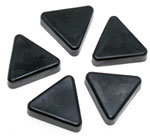 Steinmusic Magic Stones are 1 1/2″ triangular-shaped polycarbonate “stones” designed to be used in conjunction with the H2 Harmonizer and purporting to intensify its effectiveness. They are ideally located at about 5 feet off the floor on the wall between your loudspeakers; behind your listening seat; on the ceiling (if possible, between your listening seat and the loudspeakers); on the edges of the loudspeakers – above the tweeters – and lastly, in the corners of your room.
Steinmusic Magic Stones are 1 1/2″ triangular-shaped polycarbonate “stones” designed to be used in conjunction with the H2 Harmonizer and purporting to intensify its effectiveness. They are ideally located at about 5 feet off the floor on the wall between your loudspeakers; behind your listening seat; on the ceiling (if possible, between your listening seat and the loudspeakers); on the edges of the loudspeakers – above the tweeters – and lastly, in the corners of your room.
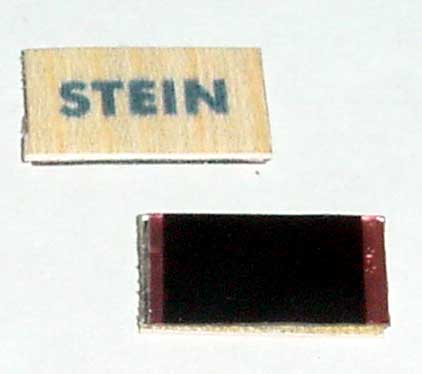 Steinmusic E-Pads are small (1″ long by 1/2″ wide) self-adhesive devices which Holger Stein says offer a” radical sonic impact on the reproduction of music.” The E-Pads work at the molecular level on whatever material it is applied to. I tried the E-Pads on almost everything in my listening room, and although they may work as the manufacturer claims, I couldn’t hear a difference.
Steinmusic E-Pads are small (1″ long by 1/2″ wide) self-adhesive devices which Holger Stein says offer a” radical sonic impact on the reproduction of music.” The E-Pads work at the molecular level on whatever material it is applied to. I tried the E-Pads on almost everything in my listening room, and although they may work as the manufacturer claims, I couldn’t hear a difference.
But what about the H2 Harmonizer combined with the Magic Stones?
In a word, ASTONISHING! I’ve a single H2B and two H2As (set at an Intensity level of 11 o’clock as recommended) and ten Magic Stones. And it took me all of 30 seconds to detect something unusually sweet about the top end. There’s also a more obvious sense of bloom around instruments. I haven’t changed any of my electronic components upstairs in years, and I’m so satisfied with their sonic performance that I don’t plan to make any changes. Yet, this stable environment began to sound very unfamiliar—and, incredibly, for the better. High-frequency decay and shimmer in instruments like cymbals and strings sounded freer, faster, and clearer, unlike anything I’ve heard before in this room. Experimenting with the Intensity knob to 12 o’clock exaggerated the effect and thus destroyed the illusion of real instruments playing in front of me. Returning to the recommended 11 o’clock position snapped everything back into focus, and once again, the top-end turned ultra-liquid. In no time, I found myself once again scratching my head in amazement.
 Listening to the H2, I get the sensation that I’m listening at a different altitude, but instead of feeling that annoying pressure I usually get in my ears at 35,000 feet, it’s the complete opposite – I feel an intense freedom from pressure. Strange but true. Bass is faster in its ebb and flow, with greater clarity and articulation.
Listening to the H2, I get the sensation that I’m listening at a different altitude, but instead of feeling that annoying pressure I usually get in my ears at 35,000 feet, it’s the complete opposite – I feel an intense freedom from pressure. Strange but true. Bass is faster in its ebb and flow, with greater clarity and articulation.
As a result, voices possess a more authentic timbre and are realistically enhanced in a three-dimensional plane, creating an exhilarating effect. On Individuality (Can I be me?) CD, Rachelle Farrell sounded a tad forward, yet rounder with greater bloom around her magnificent voice. Simultaneously, she seemed further distanced from her bandmates with no embellishment or exaggeration in size whatsoever. In short, dynamically, my room sounds like someone or something removed the corners of the ceiling and floor. Voices soar higher via the H2s, with less restraint and more realism. I am still trying to make sense of the whole thing as I write this.
It’s amazing to think a system as tweaked out with products such as room correction (Behold), Acoustic Revive RWL-3 room panels, one dozen of Franck Tchang’s Gold Resonators, Shakti Stones and two pairs of Hallographs, not to mention the age-old Argent Room lens, would benefit from a device that makes claims about stimulating oxygen molecules!
Taking the show on the road.
David Caplan is the co-creator of the Shakti Hallographs and is a tweakaholic if there ever was one. I’m talking about a guy who’s using eight sets of Hallographs in his listening room. Now, Caplan lives in Brooklyn, NY, which is about twenty minutes from my home. I called him to ask if he’d be interested in hearing something remarkable, and he was. I arrived with not a mention of the H2s (fearing he’d Google the damn things), we listened for a good thirty minutes as we always do when I visit Caplan. Then I asked if he’d install the Magic Stones in the same positions as I did in my home. After completing that task, we installed the H2A behind his audio rack and the H2B near the listening couch. I asked him to put on some familiar music and listen. I could see Caplan’s eyes widen in disbelief…in about thirty seconds! He adores his Apogee Stage loudspeakers, which I think have seen their best days because, for me, they lack dynamics and bass authority. (This is not a secret. It’s well documented that the Achilles heel of open-baffle, dipole-based designs is bass and dynamics.) The first improvements we noticed were in bass and dynamics. I would have never believed this degree of improvement possible. Not in a thousand years. They were so noticeable and evident that we both felt giddy over the results. Whenever Caplan and I talk, he always stresses over and over, “it’s all about the room and addressing distortions.” Well, he hit the nail on the head this time.
Theory versus Reality.
I have a hunch as to what the H2’s doing. To my ears, if there’s some truth to Stein’s claim of the manipulation of air molecules, then the H2’s are impacting right at the reflective surfaces: the ceiling above, behind my head, and in the corners. This makes it much closer to a type of room correction device than anything else I can imagine. I’ve tried basically everything else under the sun when it comes to taming a room, and the H2, to my ears, sounds closer to room correction than anything else I’ve encountered. Sounds crazy? Yeah, I think so too. A friend hypothesized that the H2 was working on the listener rather than the room. My answer was, Then why do you sound the same to me when we talk, but the music is so different? (And no, we did not go to the corner of the room and try listening to our voices.)
I don’t want to delve too deeply into comparisons, but I will say here for the record that I’ve not heard anything passively affect a room like the H2. If there’s such a thing as a de-stressor device, then that’s what it sounds like to me. The H2, in my opinion, is nothing short of breathtaking. There will be more discussion of this innovative product in the not-too-distant future. My impressions are solid; they’re still early, as I’ve had the unit for less than a month. As time and settling time continue, I hope to report more on any observed differences.
The Steinmusic H2 Harmonizers and Magic Stones have altered my perception of what is sonically possible in the present moment. Their impact is powerful enough to rival the Bybee Super Effect Speaker Bullets, Frank Tchang’s Acoustic Resonators, and Shakti Hallographs.

![]()
clement perry
Stein Music Harmonizers:
Price: $2,500.00 (includes 10 Magical Stones and 10 E-Pads)
Website: www.steinmusic.de
Contact: Laufer Teknik
Laufer Teknik
360 Southbury Road
Roxbury, CT 06783
860 355-4484
http://www.lauferteknik.net
![]()
Don’t forget to bookmark us! (CTRL-SHFT-D)
Stereo Times Masthead
Publisher/Founder
Clement Perry
Editor
Dave Thomas
Senior Editors
Frank Alles, Mike Girardi, Russell Lichter, Terry London, Moreno Mitchell, Paul Szabady, Bill Wells, Mike Wright, and Stephen Yan,
Current Contributors
David Abramson, Tim Barrall, Dave Allison, Ron Cook, Lewis Dardick, John Hoffman, Dan Secula, Don Shaulis, Greg Simmons, Eric Teh, Greg Voth, Richard Willie, Ed Van Winkle, Rob Dockery, Richard Doron, and Daveed Turek
Site Management Clement Perry
Ad Designer: Martin Perry





Be the first to comment on: Steinmusic’s H2 Harmonizer, Magic Stones and E-Pads